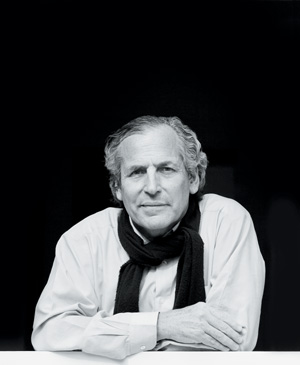13. Light and Authenticity
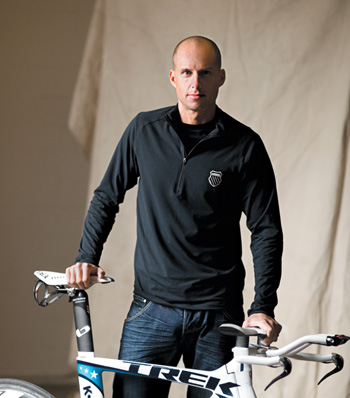
I was assigned to shoot a professional athlete for the cover of a major magazine. The photo editor explained that he didn’t want the typical athlete plastered with logos and lit with artificial light. He wanted a more natural and authentic mood. This window light picture was the one he selected for the cover.
Canon 5DMii, 85mm lens, f/1.6
PEOPLE PHOTOGRAPHERS tell stories with light. Sometimes these stories stay on the surface and reflect what’s on the outside. Other times the light reveals what the human eye cannot see. The light becomes a soft beam that shines into the darkness, exposing inner truths that are buried deep within.
Light is valuable, and we pay attention to it in so many different ways. In photographs, the eye first looks at areas of brightness and then to focus, contrast, and color. Creating effective photographs calls for deepening our understanding of this and developing a special sensibility to the moods of light, ranging from delicate and fragile to unforgiving and harsh.
When it comes to creating pictures of people, I’ve found that natural and available light gives pictures a more authentic voice. There is something unique that happens when working with the natural elements. Whether inside or out, it adds a reality to the pictures that is inviting and true. And isn’t authenticity what we really value and want?
Less Gear and More Agile
Creating authentic photographs doesn’t require using elaborate studios setups and excessive amounts of gear. In order to grow as a photographer, why not disregard all of the typical sales-driven marketing advice? Try something different and test the old adage that less is more. When you take a minimalist approach, choosing a simple location and using less gear, you become more agile as a photographer and you make less noise. With less of you, there is more potential for the subject to be at ease and for you to create lasting images.
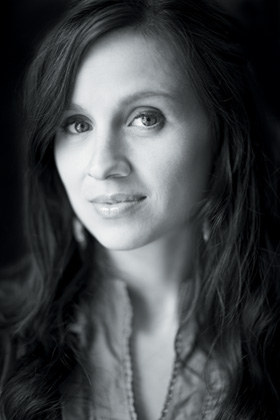
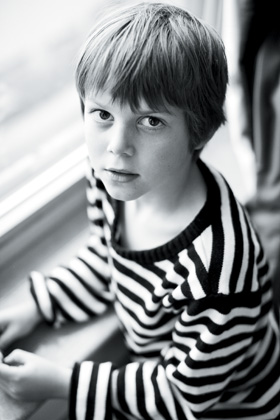
Windows are a wonderful source both for the quality of natural light and for the simple means of creating pictures that put the subject at ease.
LEFT Melissa stands by a window at work.
RIGHT Geivan sits next to his bedroom window.
Left: Canon 5DMii, 85mm lens, f/1.2
Right: Canon 5DMii, 50mm lens, f/2
Exercise: Windows and Garage Doors
Position someone next to a window or inside an open garage and they will most likely be at ease. People like to be on the inside looking out, gazing at the world and weather outside. For centuries artists have used the soft illuminated light that only a window can provide. This tradition is deep and wide; now it’s your turn to contribute to this large genre of art.
Think of the following steps as a chance to follow this type of less-is-more approach. This is an opportunity to work with two similar types of available light and with just one camera and lens. The goal is to create ten good portraits in each place.
Step 1 Windows
Find a window without directional light—i.e., where the sun doesn’t stream directly in. Look for indirect light that is exquisite and soft. Set up a photo shoot with a subject for a short duration of time, say 10 to 15 minutes. After a 5-minute meet and greet, start off the shoot by trying different ideas out: Change your subject’s angle and position, and have him stand or sit. Really work the scenario and do this as a way to figure out what is possible. It’s OK if you make mistakes; the point is to experiment within the setting.
Tips
Natural or available light photography can be challenging, but don’t give up. Let Henri Cartier-Bresson’s words inspire you: “Avoid making a commotion, just as you wouldn’t stir up the water before fishing. Don’t use a flash out of respect for the natural lighting, even when there isn’t any.”
Even the most ordinary window can create exquisite light.
When working with soft, indirect light, there’s no need to rush. You will discover that because the light is subtle it requires a more calm approach. Take a deep breath and patiently capture what you see.
Eventually, near the end of the shoot settle down into the position you think is working best. Inform the subject that you want to create a portrait that is present and engaged. Ask him to take a deep breath. Be patient and look for the moment that is best.
Step 2 Garage Doors
For those who prefer subtlety, one of the best and most underused locations is an ordinary garage. The simplicity of the garage makes it a bit easier to let loose as a photographer and your subject will feel at ease.
Open the garage door and position the subject in the shadow near the edge. You will discover the light is like nothing else you have seen. If necessary, hang a backdrop behind the subject to cover up all the clutter. The garage creates a box, which protects the subject from direct sun. The sky adds a sparkle to their eyes. In a sense a garage door opening is like a big window without glass. And if the driveway is a light-colored concrete, it can act as a reflector bouncing the fill light back in.
Exercise Details
Goal: Capture 20 strong portraits. Tools: Camera; 85mm or similar length lens. Light: Soft, indirect light. Locations: Window and garage. Theme: Light. Duration: 10 to 15 minutes per person at each location.
If you don’t have a garage, any overhang will do. Experiment with positioning the subject closer and farther from the shadow’s edge until you find the right combination. Try using a small stepladder or stool so that you can position the camera just above the subject’s head. This will cause him to look up so that the light from the sky will brighten his eyes. Keep this session short, from 10 to 15 minutes.
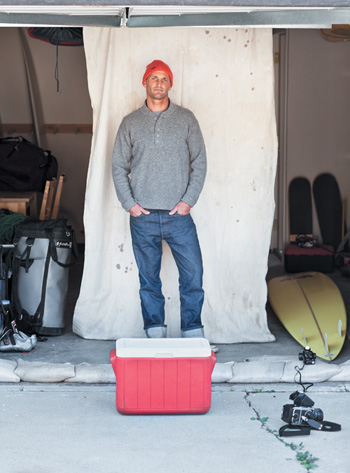
LEFT I found an old painter’s drop cloth for a great back drop. I stood on the red cooler to elevate the position of the camera so the light from the sky would reflect in his eyes. The subject was on his own turf and surrounded by his stuff: surfboards, skateboards, climbing gear, and cycling shoes. This made for a more relaxed and comfortable shoot. (See end of Exercise 5 for another picture.)
Canon 5DMii, 85mm lens, f/3.2
OPPOSITE Photographer Rodney Smith standing at a Dutch door at his home in New York. This setting provides the combination of a door and window together. He stands on the inside looking out as the diffused light illuminates the scene.
Canon 5DMii, 85mm lens, f/4
“Light—with all its glorious variation from day to day, city to city, latitude to latitude—is my source of inspiration. I almost exclusively use natural light and I like to see the subject as our eyes view it but with more focus and more intent.”
—Rodney Smith

